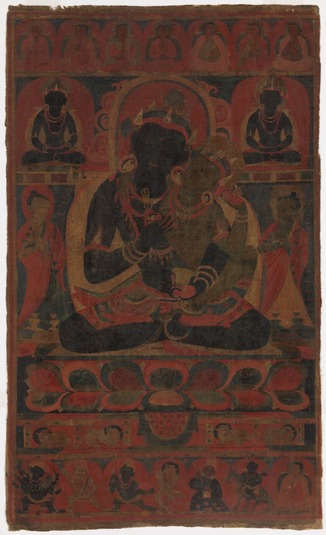
Item: Vajrasattva (Buddhist Deity) - Blue
| Origin Location | Tibet |
|---|---|
| Date Range | 1200 - 1299 |
| Lineages | Nyingma and Buddhist |
| Material | Ground Mineral Pigment on Cotton |
| Collection | Private |
Classification: Deity
Akshobhya Vajrasattva and consort Vajradhatu Ishvari, from a five composition painting set related to the Guhyagarbha Tantra of the Nyingma Tradition of Tibetan Buddhism.

Seated above at the left and right sides are the male primordial Buddha Kuntu Zangpo and the consort Kuntu Zangmo. Both are blue in colour, wearing crowns, jewerly and a lower garment, with the hands folded in the lap in a gesture of meditation, with the two legs folded in vajra posture. Standing at the sides are two of the Six Sages of the Six Realms: Sage of the Gods and Sage of the Asuras. The two are standing, each with a prominent ushnisha, the hands at the heart in a gesture of respect, wearing monastic robes.
Along the top, identified by inscriptions, beginning at the left side are Vimala (8th century), Lotsawa Ma Rinchen Chog (11th century), Gyere Chogyong, Rinchen Zhonnu, Shang Gyalwa'i Yonten, Nub Sanggye Yeshe (b.844?), and Sherab Chog.
Along the bottom, identified by inscription, are Vajrakila, Vishvavajra (?), Vajravidarana, Dakini Simhamukha, Iron Mahakala and Shri Devi. At the bottom right corner sits a monastic figure with the inscription reading Lama Shakya Jangchub.
The composition should properly be dated no earlier than after the passing of Nyangral Nyima Ozer (mnga' bdag nyang/myang ral nyi ma 'od zer. b.1124/1136 - d.1192/1204 [TBRC P364]). Nyangral was responsible for incorporating the 'New Translation' (Sarma) deities Vajravidarana, and Dakini Simhamukha into the Nyingma 'Kama' tradition. It is noteworthy that the figure of Nyangral is not among the secondary figures.
The inscriptions on the painting are problematic. The Tibetan inscription for the central Vajrasattva is written in block script 'with a head.' All of the secondary figure inscriptions are written in cursive 'without a head.' The inscriptions for the two standing buddhas to the right and left of the central figure appear to be written by two different hands with spelling errors.
The age of the painting cannot conclusively be dated to the life of the figure Shakya Jangchub located at the bottom right corner. This composition is the first of the five painting set. It is conceivable that each painting might have a figure in the bottom right corner extending the lineage for another four generations if those figures are a continuation of the lineage, or perhaps containing several lineage figures in each of the four missing compositions.
Nubchen Sanggye Yeshe is mentioned in the Mindrolling lineage of the Iron Mahakala. The lineage of teachers for the Mahakala are: Vajradhara, Vajrapani, Shantigarbha, Rombuguhya, Dragtung Nagpo, Gegpa Dorje, Vasudhara, Nubchen, Drang Nga Kundrag, Soban Bum Drag, Kyoban Tuchen, Che Dode Sengge, Rongpa Gvalo, Che Loden Sengge, Lama Siu Chungpa, Jamyang Ringyal, Chogyal Palzang, Chokyong Gyaltsen, Chokyong Rinchen, Tsarchen [Losal Gyatso, 1502-1556], etc. (Terdag Lingpa Gyurme Dorje 1646-1714 and Minling Lochen Dharmashri 1654-1718. Tibetan source text 'dod 'jo bum bzang, Part II, page 30). Note that this lineage is identical to that of Mahakala Vyaghra Vahana and others.
Jeff Watt 7-2018
Subject: Tatagatas & Figures (Similar Characteristics)
Subject: Guhyagarbha Tantra (Peaceful & Wrathful Deities)
Buddhist Deity: Vajrasattva Main Page
Buddhist Deity: Vajrasattva Masterworks (Painting)
Subject: Confused Iconography (Akshobhya, Vajrasattva, Vajrapani)
Subject: Confusions (Vajrasattva & Vajrapani)



